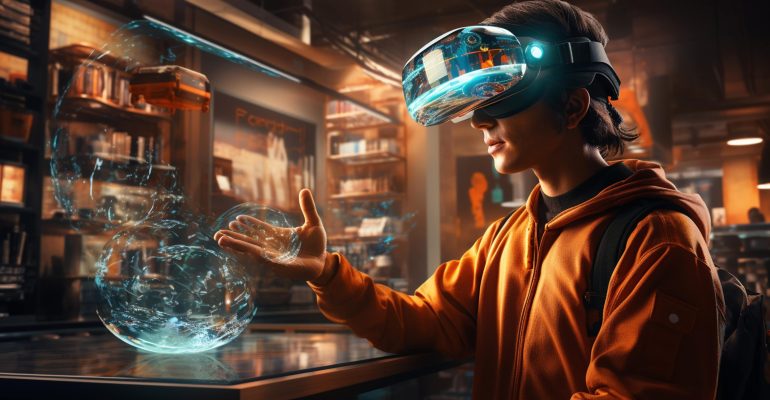
Immersive Product Development Innovations

Immersive Product Development Innovations
The integration of Virtual Reality (VR) and Augmented Reality (AR) in product development is revolutionizing industries by enhancing creativity, improving efficiency, and reducing costs. These immersive technologies empower companies to visualize, prototype, and test products in ways that were unimaginable a few years ago. As the demand for AR and VR solutions grows, choosing the right AR VR development company has become crucial for businesses aiming to stay competitive.
Evolution of AR and VR in Product Development
Product development traditionally relied on physical prototypes and 2D drawings, which often led to extended timelines and higher costs. AR and VR technologies have changed this narrative by providing interactive, 3D environments that facilitate real-time collaboration and testing. Companies can now simulate real-world conditions, optimize designs, and streamline manufacturing processes before actual production begins.
Key Applications of AR and VR in Product Development
- Prototyping and Design Visualization
- AR VR development allows engineers and designers to create virtual prototypes, enabling them to explore product designs in immersive 3D environments. These prototypes are not only cost-effective but also allow stakeholders to interact with the design as if it were real.
- An AR app development company can develop applications that overlay digital models onto physical objects, providing context-sensitive insights during the design phase.
- Collaboration and Remote Development
- Global teams can collaborate seamlessly using AR and VR platforms. These technologies bridge the gap between geographically dispersed teams, enabling real-time interactions and decision-making.
- An AR VR app development company plays a crucial role in creating platforms that foster collaboration, ensuring that every team member, regardless of location, has access to the same immersive environment.
- Simulation and Testing
- VR environments simulate real-world scenarios where products can be tested under various conditions. This eliminates the need for expensive physical testing and reduces the risk of errors in the final product.
- For instance, an augmented reality app development company can develop AR solutions that simulate how a product would function in different settings, providing valuable feedback during the early stages of development.
- Training and Skill Development
- AR and VR are invaluable tools for training employees on new product designs or manufacturing techniques. Immersive training modules enhance learning and ensure that workers are better prepared to handle the product or process.
- Companies offering augmented reality development services can create tailored training programs that cater to specific industry needs.
- Customer Engagement and Feedback
- Integrating AR and VR in the product lifecycle enables companies to involve customers during the development phase. Virtual showrooms and AR-enabled applications allow customers to visualize and customize products, providing valuable insights to designers.
- Businesses can partner with an AR VR development company to create interactive platforms that make customer engagement more dynamic and informative.
Industries Benefiting from AR and VR in Product Development
- Automotive
- Companies like Ford and Tesla use VR for designing car interiors and exteriors. By visualizing models in virtual environments, they reduce development time and improve precision.
- An AR VR solutions provider can help automotive companies integrate these technologies for a competitive edge.
- Consumer Electronics
- From smartphones to wearable gadgets, AR and VR aid in testing product ergonomics and performance. They ensure the product meets user expectations even before manufacturing begins.
- Healthcare
- Medical device companies leverage AR and VR to simulate surgeries and test devices in virtual environments. These technologies help identify design flaws early, ensuring patient safety.
- Retail and E-commerce
- Virtual try-ons and AR-enabled product demos enhance customer experiences, ensuring higher satisfaction and reduced return rates.
Choosing the Right Development Partner
To successfully integrate AR and VR into product development, businesses must collaborate with the right technology partner. Here’s what to look for:
- Experience and Expertise
- Opt for an AR VR development company with a proven track record of delivering successful projects across various industries.
- Custom Solutions
- Ensure the company provides tailored solutions. Whether you need a virtual prototyping tool or an AR-based customer feedback system, the provider should cater to your specific needs.
- Support and Maintenance
- Choose an AR VR app development company that offers ongoing support and updates to ensure your application remains relevant as technology evolves.
Future Trends in AR and VR for Product Development
The adoption of AR and VR is set to grow further with advancements in spatial computing, haptic feedback, and AI integration. Future applications will include more sophisticated simulations, predictive analytics, and enhanced remote collaboration tools.
Companies investing in AR and VR now will be well-positioned to harness these innovations. Partnering with a reliable AR VR development company in the USA or globally will help businesses not only meet current market demands but also lead the way in innovation.
Conclusion
AR and VR have undeniably transformed the product development landscape. From design visualization to customer feedback, these technologies ensure a seamless and efficient process, minimizing costs and maximizing creativity. Collaborating with an experienced AR VR app development company can help businesses unlock the full potential of these technologies, paving the way for a future driven by innovation and immersive experiences.